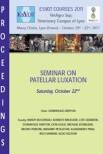There are no experimentally validated pharmacological means of preventing laminitis; however, locally acting pharmaceutical agents with the potential to prevent laminitis have been identified. Demonstrating therapeutic drug concentrations in lamellar tissue is essential for evaluating the efficacy of these agents. The aim of this study was to develop an experimental technique for repeatedly sampling lamellar interstitial fluid. A technique for placing ultrafiltration probes was developed in vitro using 15 cadaver limbs. Subsequently, lamellar ultrafiltration probes were placed in one forelimb in six living horses. Interstitial fluid was collected continuously from the probes as ultrafiltrate for 4 (n = 4) or 14 days (n = 2). The rate of ultrafiltrate collection was calculated every 12 h. Biochemical analyses were performed on ultrafiltrate collected on night 1 (12–24 h post-implantation) and night 4 (84–96 h post-implantation). Sections surrounding the probe and control tissue from the contralateral limb were harvested, stained with H&E and Masson's trichrome and scored based on the tissue response to the probe.
Ultrafiltration probes were placed in the lamellar tissue in all six horses. Ultrafiltrate was collected from these probes at 55 (30–63) μL/h (median [interquartile range]). Fluid production decreased significantly with time from night 3 onwards (P 0.05). There was no significant change in the constituents of the ultrafiltrate between nights 1 and 4 (P > 0.05). The technique was well tolerated. This study demonstrates that ultrafiltration can be used to sample equine digital lamellar interstitial fluid, and has potential for measuring lamellar drug levels.









